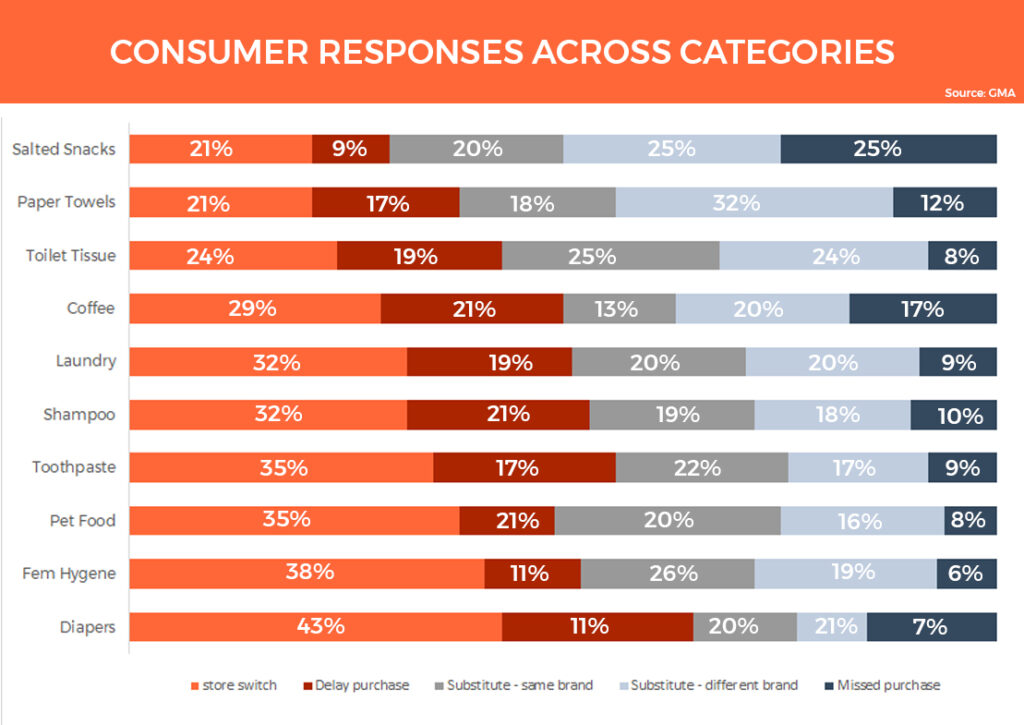Secondo un recente studio condotto da GMA, il tasso di OOS in Europa si aggira intorno all'8,6%. Questo dato aumenta durante le prime ore della sera e in determinati giorni della settimana. La maggior parte delle situazioni di OOS si verifica la domenica. Durante la settimana, il rifornimento e i preparativi per le promozioni del sabato e della domenica portano a tassi di OOS più bassi. Sebbene il sabato sia il giorno più affollato per gli acquisti di generi alimentari, è quello con il tasso di OOS più basso, in quanto i rivenditori normalmente impiegano manodopera extra per rifornire gli scaffali e le scorte di articoli promozionali.

I FATTORI CHE INFLUENZANO L'OOS
Le promozioni influenzano fortemente i tassi di esaurimento scorte. Secondo diversi studi condotti nel corso degli anni, i tassi di OOS tendono a essere due volte più alti per gli articoli in promozione. In generale, l'ammontare dello sconto offerto durante una promozione corrisponde al tasso di OOS.
La velocità di movimento dei prodotti è un altro fattore che influenza il tasso di OOS. Infatti, i prodotti in rapida evoluzione, che siano in promozione o meno, tendono ad avere un tasso di OOS superiore del 50%-80% rispetto agli altri prodotti.
COME REAGISCONO I CONSUMATORI ALLE SITUAZIONI DI OOS?
Ci sono cinque risposte principali che i consumatori adottano quando il prodotto che intendono acquistare è esaurito:
1) Acquistare l'articolo in un altro negozio
2) Rimandare l'acquisto nello stesso negozio
3) Sostituire l'articolo con una taglia o un tipo diverso della stessa marca
4) Passare a un prodotto simile di un'altra marca
5) Non acquistare l'articolo affatto
Tutte queste risposte hanno conseguenze negative e comportano perdite sia per i rivenditori che per i produttori. A livello mondiale, la perdita media di vendite dovuta agli OOS è del 3,9%.

La risposta dei consumatori varia anche in base alla categoria di prodotto.
Per esempio, la carta igienica presenta alti livelli di sostituzione, mentre i prodotti per l'igiene femminile e i pannolini mostrano livelli molto alti di cambio di negozio e bassi livelli di ritardo nell'acquisto.
La categoria degli snack salati presenta il livello più alto di consumatori che non effettuano alcun acquisto.

Le diverse risposte generano perdite diverse per i rivenditori e i produttori. In generale, le categorie di maggior perdita per i dettaglianti hanno un effetto minore sul produttore e viceversa. Inoltre, quando un consumatore sostituisce un prodotto a causa di una situazione di OOS, la tendenza in un cambio di marca è quella di acquistare al ribasso sia in termini di dimensioni che di prezzo.
LE CAUSE PIÙ COMUNI DI UNA SITUAZIONE DI ESAURIMENTO DELLE SCORTE
Secondo diversi studi, circa un terzo delle situazioni di OOS può essere attribuito a problemi di rifornimento, cioè alla presenza del prodotto in negozio ma alla sua mancata distribuzione sugli scaffali. Un quinto delle situazioni di OOS è dovuto a decisioni di pianificazione, tra cui l'allocazione inadeguata dello spazio a scaffale e la scarsa conformità al planogramma. Ciò implica che la maggior parte della responsabilità per gli OOS risiede ai piani alti dell'organizzazione di vendita al dettaglio.

A livello globale, l'Europa presenta il maggior numero di problemi di rifornimento, che derivano da pratiche di negozio che prevedono un riempimento degli scaffali infrequente, tardivo o assente, una scarsa esecuzione del planogramma, personale insufficiente o magazzini congestionati in cui le scorte non si trovano o sono danneggiate.
RISOLVERE LE SFIDE DELL'OOS CON IL CROWDSOURCING
Leattività di merchandising in negozio supportate dalla folla possono aiutare i retailer a scoprire le situazioni di OOS e a risolverle prima che abbiano un impatto sulle vendite e sulla soddisfazione dei clienti.
Grazie all'accesso in tempo reale ai dati sulla salute degli scaffali, sulla disponibilità e sull'esecuzione delle promozioni, i professionisti del retail sono in grado di riconoscere i principali problemi che potrebbero compromettere il viaggio del cliente e possono intervenire per risolverli in modo più rapido ed economico.
La folla di Roamler conta più di 600.000 acquirenti in tutta Europa che, grazie alla tecnologia mobile, possono condividere facilmente informazioni e foto da tutti i negozi d'Europa e intervenire su richiesta.
Volete sapere come potete utilizzare il crowdsourcing per ridurre i tassi di OOS? Contattate i nostri esperti.